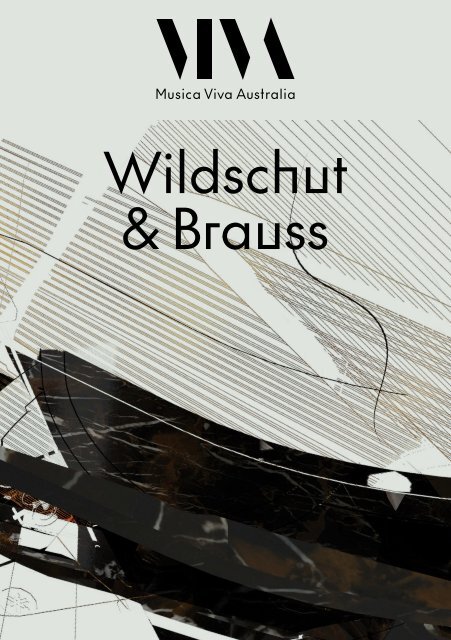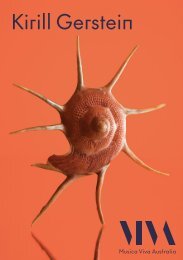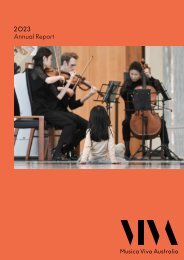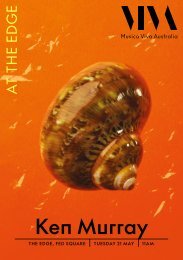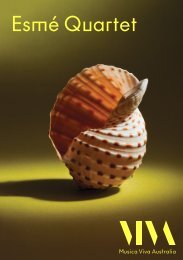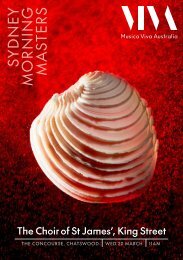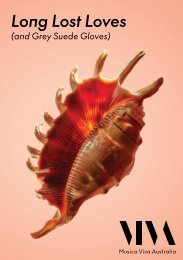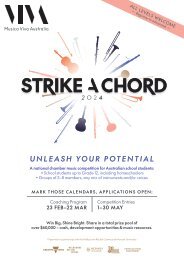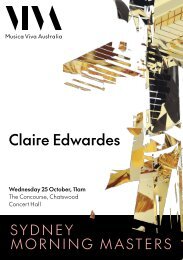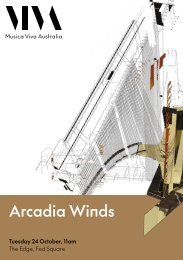Create successful ePaper yourself
Turn your PDF publications into a flip-book with our unique Google optimized e-Paper software.
<strong>Wildschut</strong><br />
& <strong>Brauss</strong>
2
We acknowledge the Traditional Custodians of the many lands on which we meet,<br />
work and live, and we pay our respects to Elders past and present – people who<br />
have sung their songs, danced their dances and told their stories on these lands<br />
for thousands of generations, and who continue to do so.<br />
NOA WILDSCHUT & ELISABETH BRAUSS<br />
violin<br />
piano<br />
ADELAIDE<br />
Adelaide Town Hall<br />
Wednesday 15 <strong>November</strong>, 7.30pm<br />
• Pre-concert talk: 6.45pm,<br />
Prince Alfred Room<br />
NEWCASTLE<br />
City Hall<br />
Tuesday 21 <strong>November</strong>, 7.30pm<br />
• Pre-concert talk: 6.45pm,<br />
Mulubinba Room<br />
BRISBANE<br />
Conservatorium Theatre,<br />
Griffith University, South Bank<br />
Thursday 23 <strong>November</strong>, 7pm<br />
• Pre-concert talk: 6.15pm, Boardroom,<br />
Qld Conservatorium, Griffith University<br />
CANBERRA<br />
Llewellyn Hall,<br />
ANU School of Music<br />
Monday 27 <strong>November</strong>, 7pm<br />
• Pre-concert talk: 6.15pm,<br />
Larry Sitsky Room<br />
• Meet the Artists after the concert<br />
MELBOURNE<br />
Elisabeth Murdoch Hall,<br />
Melbourne Recital Centre<br />
Saturday 25 <strong>November</strong>, 7pm<br />
• Pre-concert talk: 6.15pm,<br />
Salzer Suite, Level 2<br />
• Meet the Artists after the concert<br />
Tuesday 28 <strong>November</strong>, 7pm<br />
• Pre-concert talk: 6.15pm,<br />
Salzer Suite, Level 2<br />
PERTH<br />
Perth Concert Hall<br />
Monday 13 <strong>November</strong>, 7.30pm<br />
• Pre-concert talk: 6.45pm,<br />
Corner Stage Riverside, Terrace Level<br />
SYDNEY<br />
City Recital Hall<br />
Saturday 18 <strong>November</strong>, 2pm<br />
• Pre-concert talk: 1.15pm,<br />
Function Room, Level 1<br />
• CD signing after the concert,<br />
Main Foyer<br />
Monday 20 <strong>November</strong>, 7pm<br />
Recorded for broadcast by ABC Classic<br />
• Pre-concert talk: 6.15pm,<br />
Function Room, Level 1<br />
• Meet the Artists after the concert,<br />
Concert Hall<br />
—<br />
With special thanks to Eleanore Goodridge OAM for her support of this tour,<br />
and to the Producers’ Circle and Amadeus Society for their support of the <strong>2023</strong> Concert Season.<br />
01
From the Artistic Director<br />
Most people can recall milestone recordings<br />
at the point in which they entered their lives.<br />
I can remember buying a double LP of Wagner<br />
overtures and preludes in my teens and<br />
consuming it whole. Same with Sviatoslav Richter<br />
playing Bach’s 48 Preludes and Fugues – perhaps<br />
not the most obvious partnership between<br />
composer and executant, but anything either<br />
man did was fine by me.<br />
© Darren Leigh Roberts<br />
The same goes with milestone performances.<br />
Simon Rattle doing Sibelius 7 at the Proms in the<br />
mid-1990s. Ann Murray singing Schubert at the<br />
Wigmore Hall a few years later. I could probably<br />
even tell you what I was wearing.<br />
I had a similar response hearing Noa <strong>Wildschut</strong><br />
and Elisabeth <strong>Brauss</strong> in 2019. It was online, alas,<br />
and I didn’t know what was just round the corner,<br />
but I was mesmerised by their performance of<br />
the Franck Violin Sonata. This is such a revealing<br />
piece. Is there stillness in the opening movement?<br />
Heart in the Recitativo-Fantasia? A cumulatively<br />
rhapsodic character in the Finale? There was all<br />
of this and more in their performance; I had a new<br />
favourite pairing. How brilliant that my invitation<br />
for them to tour Australia back then is finally<br />
bearing fruit.<br />
I could say the same thing about May Lyon whose<br />
commissioned work for violin and piano, Forces<br />
of Nature, will receive its premiere performances<br />
on this tour. I marvelled at May’s work Opal,<br />
a concerto for two horns, performed by the<br />
Melbourne Symphony Orchestra two years ago,<br />
and determined there and then that Musica Viva<br />
Australia would commission new music from this<br />
composer. It’s a lovely fit, as Noa and Elisabeth<br />
agreed when hearing some of May’s music, and a<br />
real pleasure for Musica Viva Australia to facilitate<br />
the creation of a new piece of the repertory,<br />
generously supported by Christine Bollen, Peter<br />
Cumines, Elizabeth Dooley, Annabel Wheeler,<br />
and Elizabeth and Rod King.<br />
Paul Kildea<br />
Artistic Director<br />
02
Program<br />
Robert SCHUMANN (1810–1856)<br />
Violin Sonata No. 1 in A minor, Op. 105 (1851)<br />
I Mit leidenschaftlichem Ausdruck (Passionately expressive)<br />
II Allegretto (Fairly fast)<br />
III Lebhaft (Lively)<br />
18 min<br />
Olivier MESSIAEN (1908–1992)<br />
Thème et variations (1932)<br />
Claude DEBUSSY (1862–1918)<br />
Sonata for Violin and Piano in G minor (1917)<br />
I Allegro vivo (Fast and lively)<br />
II Intermède: Fantasque et léger (Intermezzo: Whimsical and light)<br />
III Finale: Très animé (Very animated)<br />
8 min<br />
15 min<br />
INTERVAL<br />
May LYON (b 1979)<br />
Forces of Nature (<strong>2023</strong>)<br />
World premiere performances.<br />
Commissioned for Musica Viva Australia by Christine Bollen, Peter Cumines,<br />
Elizabeth Dooley, Annabel Wheeler, and Elizabeth and Rod King.<br />
In memory of Ian Bollen and in memory of Iris Mara.<br />
12 min<br />
Program 1 only | Adelaide, Canberra, Melbourne (Saturday), Perth, Sydney (Monday)<br />
George ENESCU (1881–1955)<br />
Violin Sonata No. 3 in A minor, Op. 25 (1926)<br />
I<br />
II<br />
III<br />
Moderato malinconico (Moderately fast, melancholy)<br />
Andante sostenuto e misterioso<br />
(Moving along at a walking pace; sustained and mysterious)<br />
Allegro con brio, ma non troppo mosso<br />
(Lively and energetic, but not too fast)<br />
24 min<br />
Program 2 only | Brisbane, Melbourne (Tuesday), Newcastle, Sydney (Saturday)<br />
César FRANCK (1822–1890)<br />
Sonata in A major for Violin and Piano (1886)<br />
I Allegretto ben moderato (Fairly fast, at a very moderate pace)<br />
II Allegro (Fast)<br />
III Ben moderato (At a very moderate pace): Recitativo-Fantasia<br />
IV Allegretto poco mosso (Fairly fast, moving along a little)<br />
27 min<br />
Please ensure that mobile phones are turned to silent.<br />
Photography and video recording are not permitted during the performance.<br />
03
Hands up!<br />
…if you know over 90% of Musica Viva Australia audiences are under 15?<br />
—<br />
Every year we present over 1,000 performances<br />
to more than 150,000 students live in schools across Australia.<br />
—<br />
Throughout 2024 there will be drumming, dancing and musical fun for students,<br />
supported by online resources and a parallel program of<br />
Professional Development for teachers.<br />
If you or someone you know is interested in finding out more<br />
about Musica Viva Australia In Schools:<br />
or<br />
VISIT<br />
SIGN UP<br />
STRIKE A CHORD 2O24<br />
Musica Viva Australia’s national chamber music competition for high<br />
school musicians is back in 2024. Do you know any secondary school<br />
students who have a passion for music? The Strike A Chord competition<br />
provides training and performing opportunities to young performers<br />
of all levels to develop their ensemble skills, fostering participation<br />
and a lifelong love of music. It’s more fun playing together!<br />
DETAILS
Regional Touring<br />
As part of Musica Viva Australia‘s Regional<br />
Touring Program, Noa and Elisabeth will<br />
perform a concert for Coffs Harbour Music<br />
Society on Thursday 30 <strong>November</strong>, 7.30pm<br />
at the Coffs Harbour Education Campus,<br />
Lecture Theatre D.<br />
—<br />
For further details visit:<br />
musicaviva.com.au/regional<br />
Masterclasses<br />
Musica Viva Australia creates opportunities<br />
for Australian and internationally acclaimed<br />
artists to share their experience and<br />
expertise with talented early-career artists<br />
and young music students, creating an<br />
enriching learning experience.<br />
Vision String Quartet in Tyalgum during their recent regional tour<br />
© Sean Moloney<br />
The following masterclasses are<br />
presented as part of this tour:<br />
NOA WILDSCHUT<br />
• Tuesday 14 <strong>November</strong>: Perth<br />
Western Australian Academy<br />
of the Performing Arts<br />
ELISABETH BRAUSS<br />
• Wednesday 22 <strong>November</strong>: Brisbane<br />
Queensland Conservatorium,<br />
Griffith University<br />
Florian Willeitner with finalists of Strike A Chord 2022<br />
© Musica Viva Australia<br />
—<br />
For further details visit:<br />
musicaviva.com.au/masterclasses<br />
Musica Viva Australia’s Masterclass<br />
program is supported by:<br />
Nicholas Callinan AO & Elizabeth Callinan<br />
Caroline & Robert Clemente<br />
Ian Frazer AM & Caroline Frazer<br />
Patricia H Reid Endowment Fund<br />
Andrew Sisson AO & Tracey Sisson<br />
Mick & Margaret Toller<br />
Anonymous (2)<br />
Musica Viva Australia Masterclasses in Western<br />
Australia are supported by Wesfarmers Arts.<br />
Timothy Ridout at Sydney Conservatorium of Music<br />
© Sean Moloney<br />
05
© Marco Borggreve<br />
Noa <strong>Wildschut</strong><br />
Dutch violinist Noa <strong>Wildschut</strong> is only 22 years<br />
old, but has already gained her place in the<br />
international classical music scene. At the age<br />
of six she appeared live on Dutch national<br />
television at Amsterdam’s Prinsengracht<br />
youth concert. Aged seven, she made her<br />
debut in the Main Hall of the Amsterdam<br />
Concertgebouw at the ‘Night of the Promising’<br />
concert. In September 2016 she became an<br />
exclusive recording artist for Warner Classics.<br />
Noa has built a considerable reputation<br />
and is regularly invited for festivals, recitals<br />
and solo performances with orchestras,<br />
both in her home country and abroad. She<br />
has collaborated with such artists as Janine<br />
Jansen, Anne-Sophie Mutter, Menahem<br />
Pressler and Igor Levit, and performed as a<br />
duo with pianists Yoram Ish-Hurwitz and, since<br />
2018, Elisabeth <strong>Brauss</strong>.<br />
She has worked with the Pittsburgh Symphony<br />
Orchestra, Royal Scottish National Orchestra,<br />
Royal Liverpool Philharmonic, Rotterdam<br />
Philharmonic Orchestra, Residentie<br />
Orkest, Netherlands Radio Philharmonic<br />
Orchestra, Netherlands Philharmonic<br />
Orchestra, Netherlands Chamber Orchestra,<br />
Concertgebouw Chamber Orchestra,<br />
Camerata Salzburg, Kremerata Baltica,<br />
Konzerthausorchester Berlin, Gürzenich<br />
Orchester Köln, Lucerne Symphony Orchestra,<br />
Sinfonieorchester Basel, Orquestra Sinfônica<br />
de João Pessoa in Brazil and Orquesta<br />
Sinfónica de Guayaquil in Ecuador.<br />
Noa won numerous awards at a young age,<br />
including First Prize at the International Violin<br />
Competition Louis Spohr in Weimar (at the<br />
age of nine), First Prize at the Iordens Violin<br />
Competition in The Hague (at the age of 10),<br />
the Concertgebouw Young Talent Award (aged<br />
11) and the Anton Kersjes Violin Prize (aged 16).<br />
She received the WEMAG Soloist Award at the<br />
2018 Mecklenburg-Vorpommern Festival, and<br />
was selected as an ECHO Rising Star for the<br />
2019/20 season by the European Concert Hall<br />
Organisation.<br />
From 2014 to 2019 Noa was a member of<br />
Mutter Virtuosi, a string ensemble led by<br />
Anne-Sophie Mutter, and from 2015 to 2019<br />
Noa held an official scholarship from the<br />
Anne-Sophie Mutter Foundation – their<br />
youngest ever member.<br />
The Dutch public service broadcaster NTR<br />
produced the documentary Noa11, which<br />
was broadcast in <strong>November</strong> 2012. In 2017 the<br />
documentary A Family Quartet, about Noa<br />
and her family, was screened in many Dutch<br />
theaters and was broadcast on TV.<br />
Noa’s bow is a beautiful Dominique Peccatte,<br />
mid-19th-century, kindly on loan from the<br />
Dutch Musical Instruments Foundation from<br />
the Tettelaar collection. Noa plays a 1750<br />
violin by Giovanni Battista Guadagnini,<br />
previously performed on by violinist Joshua<br />
Bell, generously loaned by a patron through<br />
the Tarisio Trust.<br />
06
© Monika Lawrenz<br />
Elisabeth <strong>Brauss</strong><br />
Pianist Elisabeth <strong>Brauss</strong> has been praised by<br />
Gramophone magazine for the ‘maturity and<br />
sophistication of her thoughtful interpretations’<br />
which would be ‘the pride of any pianist twice<br />
her age’. Born in Hannover in 1995, Elisabeth<br />
is quickly establishing herself as one of the<br />
most exciting and versatile musicians of her<br />
generation.<br />
As a member of the BBC New Generation<br />
Artist (NGA) scheme, Elisabeth has many solo,<br />
chamber and concerto engagements across<br />
the UK, including her debut at the BBC Proms,<br />
performing Mozart with the BBC Philharmonic<br />
Orchestra in 2021. In a new partnership<br />
between this scheme and the Hallé Orchestra,<br />
she received the 2021 Terence Judd-Hallé<br />
Award, given to an NGA graduate considered<br />
to be on the cusp of a major international<br />
career.<br />
Elisabeth has appeared with the Hallé<br />
Orchestra and the BBC Symphony,<br />
BBC Scottish Symphony and BBC Ulster<br />
Orchestras, in addition to dates with Deutsche<br />
Kammerphilharmonie Bremen, NDR<br />
Radiophilharmonie Hannover, Frankfurt Radio<br />
Symphony Orchestra, Staatsphilharmonie<br />
Nürnberg and Göttinger Symphonie<br />
Orchester in her native Germany.<br />
During the 2021/22 season her solo<br />
performances included enagements in<br />
Cologne, London (Wigmore Hall) and<br />
Hamburg, where she took part in Max Richter’s<br />
Reflektor Festival at the Elbphilharmonie.<br />
She enjoys playing chamber music and has<br />
appeared with Noa <strong>Wildschut</strong> throughout<br />
Europe, including the Concertgebouw in<br />
Amsterdam and Philharmonie Halls in<br />
both Paris and Cologne, as well as the San<br />
Francisco Symphony’s Young Artists Series.<br />
Elisabeth also works regularly with the trumpet<br />
player Simon Höfele, with whom she has<br />
recently released the album New Standards.<br />
In May 2017, her debut CD, featuring works by<br />
Beethoven, Prokofiev, Chopin and Denhoff,<br />
was released by OehmsClassics. It received<br />
critical acclaim and was named Editor’s Choice<br />
by Gramophone magazine. Since then, she<br />
has also appeared on CD with cellist Valentino<br />
Worlitzsch (works by Beethoven, Ysaÿe,<br />
Schumann and Britten) and with the Beethoven<br />
Orchester Bonn for an album featuring<br />
compositions by Max Richter to commemorate<br />
Beethoven’s 250th anniversary.<br />
In addition to winning first prize at the<br />
International Steinway Competition in<br />
Hamburg and the International Grotrian<br />
Steinweg Piano Competition in Braunschweig,<br />
Elisabeth was awarded the Praetorius Music<br />
Prize by the state of Niedersachsen in 2012.<br />
Further accolades include the main and<br />
audience awards at the 2013 TONALi Grand<br />
Prix in Hamburg and First Prize at the 2016<br />
Kissinger KlavierOlymp.<br />
07
About the music<br />
as it is obsessive. The unusual Allegretto in<br />
place of a slow movement has a rhetorical<br />
quality in which Schumann’s feeling for the<br />
intersection between music and language<br />
is particularly apparent; Schumann scholar<br />
Joan Chissell has described this movement<br />
as coming ‘as near to human speech as music<br />
ever can’.<br />
© PHILIP MURRAY 2019<br />
Robert Schumann’s three violin sonatas<br />
date from the early 1850s, a period of his<br />
life when signs of the mental illness that<br />
would eventually overwhelm his final years<br />
were already beginning to appear. Some<br />
commentators have chosen to interpret certain<br />
qualities of the music of this period, such as<br />
perceived lapses in instrumental writing and<br />
formal craft, and an obsessive use of repetitive<br />
rhythmic motives, as evidence of mental<br />
disturbance. It is perhaps for this reason<br />
that Schumann’s violin sonatas have not<br />
traditionally shared the popularity of those of<br />
Beethoven and Brahms.<br />
Schumann himself apparently was not entirely<br />
satisfied with his first attempt, the Sonata in A<br />
minor, Op. 105, which we are hearing in this<br />
concert, and it is true that aspects of octave<br />
registration and doubling can cause issues<br />
of balance between the instruments. In an<br />
attempt to solve these problems, British pianist<br />
Harold Bauer published a recomposed version<br />
in 1945, which achieved a brief popularity.<br />
More recent appraisals, however, have tended<br />
towards a greater appreciation of the ways<br />
Schumann’s unique musical sensibility finds<br />
expression in this work. If understood as ‘true’<br />
chamber music, designed for performance in a<br />
small space to an intimate audience, many of<br />
the problems of balance resolve themselves.<br />
While imbued with a melancholy restlessness,<br />
the first movement Mit leidenschaftlichem<br />
Ausdruck (Passionately expressive)<br />
nevertheless possesses a formal tightness;<br />
and the rhythmic energy of the last movement,<br />
Lebhaft (Lively), is as sparklingly effervescent<br />
Olivier Messiaen wrote his Thème et<br />
Variations in 1932, only two years after<br />
finishing his studies at the Paris Conservatoire,<br />
for his first wife, the violinist Claire Delbos.<br />
Other works prompted by his feelings for<br />
her included the song cycles Poèmes pour Mi<br />
(1936) and Chants de terre et de ciel (1938).<br />
The pair gave Thème et Variations its first<br />
performance, playing their respective parts at<br />
a concert arranged by the Société Nationale<br />
de Musique.<br />
Writing about Messiaen’s music often leads<br />
to metaphors of stained-glass windows. He<br />
was a cathedral organist, and a synaesthete<br />
(perceiving sound also visually, as colour).<br />
More ephemerally, in this piece he takes an<br />
established format, gives it his own modern<br />
and distinctive voice, and allows us to hear/<br />
see his theme from different angles in the<br />
variations, just as light comes through a<br />
window at different times of day.<br />
The theme is a slow expressive melody for the<br />
violin laid out in asymmetrical phrases, with<br />
chromatic shifts in the piano part that provide<br />
08
us with a changing view of its implications.<br />
Variation 1 essentially speeds up the theme<br />
in quaver values, a procedure echoed in the<br />
exuberantly chromatic patterns for piano.<br />
Variation 2 gives the quavers a persistent<br />
triplet rhythm and Variation 3 takes the<br />
process of diminution a stage further, shrinking<br />
the theme through the use of semiquavers.<br />
Variation 4 returns to longer note-values,<br />
increasingly through repetitions of successive<br />
notes in triplet rhythms, leading to a final<br />
slow variation in which the theme’s original<br />
statement is lengthened and broadened, its<br />
values augmented, and its resonance and<br />
dynamics greatly enlarged.<br />
ADAPTED FROM A NOTE © AUSTRALIA ENSEMBLE<br />
In the Violin Sonata, the first movement,<br />
Allegro vivo, is in conventional sonata-form<br />
– its theme returns to make an introduction to<br />
the finale. The slow intermezzo, ‘whimsical and<br />
light‘, evokes the figure of Harlequin (just as<br />
the slow movement of the Cello Sonata evokes<br />
Pierrot), with touches of melancholy as well<br />
as dancing lightness. The Finale contains an<br />
exuberant rondo on a theme recalling Iberia;<br />
according to Debussy, this theme ‘is subjected<br />
to the most curious deformations and<br />
ultimately leaves the impression of an idea<br />
turning back upon itself, like a snake biting its<br />
own tail‘. Throughout, the sonata is remarkable<br />
for the beauties and subtleties of string tone<br />
and effect which Debussy has exploited with<br />
great sensitivity.<br />
© MUSICA VIVA AUSTRALIA<br />
The Sonata for Violin and Piano in G minor,<br />
completed in 1917, was Claude Debussy‘s<br />
last work. In 1915 he had set out to write a<br />
series of six sonatas for various instrumental<br />
combinations, but ill-health and general<br />
depression, accentuated by the World War<br />
whose approach he had gloomily foretold,<br />
slowed his work. He completed only three of<br />
the six: for cello and piano, for flute, viola and<br />
harp, and this sonata, for violin and piano.<br />
These works show a trend away from<br />
Debussy‘s ‘impressionistic‘ style; here the<br />
melodies, harmonies and rhythms are much<br />
more clear-cut. They anticipate the 1920s<br />
movement of neo-classicism, but rather than<br />
going back to Bach they show influences of the<br />
early French masters such as Couperin and<br />
Rameau.<br />
Composed in the leafy outer east of<br />
Melbourne, May Lyon’s music explores deep<br />
human emotions, representations of nature<br />
and mathematical concepts, as well as the<br />
lighter side of life. Stylistically eclectic, Lyon’s<br />
compositions move from dramatic and intense,<br />
to quirky.<br />
Lyon was a finalist for the <strong>2023</strong> Art Music<br />
Awards’ Work of the Year: Dramatic for the<br />
ballet Precious Bedeviller aka One Person<br />
Watching, commissioned by The Australian<br />
Ballet and choreographed by Timothy<br />
Coleman. Lyon is the <strong>2023</strong> Ensemble Offspring<br />
Noisy Women Commission Recipient and<br />
is currently studying for a Doctor of Musical<br />
Arts at the University of Sydney as part of the<br />
Composing Women Program.<br />
09
PROGRAM 1 ONLY<br />
Previously, Lyon’s music has been performed<br />
by the Melbourne Symphony Orchestra,<br />
Tasmanian Symphony Orchestra, Tasmania<br />
University Orchestra, National Capital<br />
Orchestra, Sydney Dance Company Pre-<br />
Professional Year with the Sydney Symphony<br />
Orchestra Fellows, Ensemble Goldentree, and<br />
Forest Collective.<br />
The composer writes:<br />
Forces of Nature evokes two polar opposites:<br />
the summer melt of ice sheets, and an erupting<br />
volcano. The ethereal opening solo violin<br />
line offers suggestions of shimmering light<br />
refracting off ice and near freezing water.<br />
As the piano enters, the water’s depth and<br />
slow undulation is introduced, transitioning to<br />
harsher ice caps, cracking, and a sharp cold.<br />
Light persists until falling deep beneath the<br />
waves. The second section starts with a slow<br />
agitation, a bubbling of air escaping beneath<br />
the sea bed. The lines quickly increase into<br />
a wild intensity, with jagged leaps heralding<br />
the start of the volcanic eruption, bursting<br />
into a fiery dance for the piano. Both violin<br />
and piano move from fast intensity to gentler<br />
gestures then back again, using the extremes<br />
of both instruments’ ranges and dynamics. As<br />
the volcano continues to erupt, the hot lava,<br />
while sometimes cooling over briefly, always<br />
breaks again to show its searing glow.<br />
While divided into two movements, there is no<br />
pause in this work other than for musical effect.<br />
© MAY LYON <strong>2023</strong><br />
According to the Spanish cellist Pablo Casals,<br />
Romanian musician George Enescu was ‘the<br />
greatest musical phenomenon since Mozart’.<br />
His talents as a violinist saw him graduate from<br />
the Vienna Conservatory at the age of ten.<br />
After performing in orchestras in Vienna, he<br />
studied composition at the Paris Conservatoire<br />
under Maurice Ravel, Jules Massenet and<br />
Gabriel Fauré. Enescu described himself<br />
foremost as a composer, yet he maintained a<br />
busy performing schedule in Paris, splitting his<br />
time between the French capital and Bucharest<br />
for much of his life. Like his Eastern European<br />
contemporaries Bartók and Janáček, Enescu<br />
was inspired by folk song, which he suffused<br />
with the rich harmonies of fin-de-siècle French<br />
music.<br />
His Violin Sonata No. 3, composed in 1926,<br />
exemplifies this melding of styles. Enescu uses<br />
the doina, an ornamented Eastern European<br />
dance style, to create a characteristic folk<br />
sound through chromaticism and rapid shifts<br />
in range. Enescu himself connected doina<br />
with the music he experience in childhood.<br />
At the same time, the work retains the usual<br />
three-movement, fast – slow – faster structure<br />
of late-Romantic sonatas. Rich chords<br />
and countermelodies abound in the first<br />
movement. The mysteriousness denoted by<br />
the second movement’s title develops from the<br />
persistent piano pulse and hauntingly high<br />
violin strains. The swirling rhythms and everchanging<br />
timbres of the finale bring the work<br />
to a mesmerising close.<br />
© CHAMBER MUSIC NEW ZEALAND<br />
10
PROGRAM 2 ONLY<br />
Back in 1858, he had in fact written at least<br />
a significant part of a violin sonata for the<br />
then-Cosima Liszt (later Cosima Wagner).<br />
Just how much of that abandoned work was<br />
then recycled into the 1886 sonata is unclear,<br />
but by the age of 62 when the new/old sonata<br />
emerged, Franck was at the height of his<br />
creative powers.<br />
In late September 1886, the violinist Eugène<br />
Ysaÿe married Louise Bourdau in the town of<br />
Arlon in Belgian Luxembourg. As befitting<br />
31-year-old Ysaÿe’s stature as the emerging<br />
celebrity violinist of his era, a who’s-who of<br />
classical music VIPs attended.<br />
But the French composer César Franck was<br />
not among them, having found himself<br />
unavoidably detained in Paris. So in his place,<br />
Franck sent his friend Charles Bordes and his<br />
pianist sister-in-law Léontine Bordes-Pène.<br />
They carried with them a wedding present<br />
from Franck, the manuscript of a violin sonata<br />
that the great French composer had written in<br />
honour of Ysaÿe and Louise’s nuptials.<br />
After a hasty rehearsal, Ysaÿe and Bordes-<br />
Pène played it at the wedding breakfast, to<br />
stunned guests who recognised it instantly as<br />
a masterpiece. Two months later, the same<br />
two artists gave its first public performance in<br />
Brussels to a rapturous reception, and then it<br />
was on to Paris where one reviewer described<br />
it as the sort of thing ‘that Bach might have<br />
written had he lived in our 19th century’. And<br />
history has justified that early praise. Ysaÿe<br />
championed its cause for decades all over the<br />
world, and to this day the Franck Violin Sonata<br />
remains the most revered violin sonata ever<br />
composed by a Frenchman.<br />
Whether or not Franck had originally intended<br />
it for Ysaÿe, though, remains a matter of<br />
conjecture.<br />
The theme of the first movement is gentle but<br />
sweeping. Ysaÿe played it faster than Franck<br />
had originally intended but such was its impact<br />
on listeners that Franck later adopted Ysaÿe’s<br />
tempo rather than his own in the published<br />
score, telling a friend that, from the moment<br />
he heard it, he couldn’t imagine it being<br />
interpreted any other way. ‘Don’t worry,’ he<br />
said, ‘it is he, Ysaÿe, who is right.’<br />
Things turn turbulent in the second movement<br />
(considered by some to be the ‘real’ first<br />
movement), while the third is free-structured<br />
like a fantasy. The finale is a rondo with the<br />
engaging main theme constantly re-emerging<br />
in canon, the one voice repeating the other<br />
in one of the true showpieces of the chamber<br />
music repertoire.<br />
© MARTIN BUZACOTT 2018
Meet the Artists/Interview<br />
BY STEPHANIE ESLAKE<br />
… the music emerged<br />
How do you prepare for your first tour to<br />
Australia?<br />
With a piece of new Australian music, of<br />
course.<br />
Violinist Noa <strong>Wildschut</strong> and pianist Elisabeth<br />
<strong>Brauss</strong> have embarked on their debut tour<br />
of this country, and they’ve been practising<br />
a new work written just for them. Melbourne<br />
composer May Lyon crafted an original piece<br />
of music called Forces of Nature, and the<br />
name of this Musica Viva Australia commission<br />
is matched to the strength of its soloists and<br />
writer alike.<br />
May says it all began when Musica Viva<br />
Australia’s Artistic Director Paul Kildea found<br />
himself listening to some snippets of Opal – a<br />
double horn concerto May had written for the<br />
Melbourne Symphony Orchestra back in 2021.<br />
With brass instruments glistening like precious<br />
gems, Paul was so drawn into its magical<br />
atmosphere that he asked May if he could<br />
hear an extended recording of the work, in all<br />
its beauty.<br />
From this listening experience would come an<br />
entirely new piece of music, for two entirely<br />
different instruments.<br />
‘He really loved the work, which I was very<br />
flattered by, after which he asked to catch<br />
up,’ May said of the composer’s burgeoning<br />
musical friendship with Paul. They had a ‘great<br />
meeting’ – and it kicked off the commission for<br />
<strong>Wildschut</strong> and <strong>Brauss</strong>.<br />
‘We had discussed that it was important that<br />
composers and performers are the right<br />
match,’ May shares. And the pressure is on<br />
when you’re tasked with contributing to a<br />
string of successful Musica Viva Australia<br />
commissions. This year alone, Australian<br />
composer Jakub Jankowski wrote for koto and<br />
cello (in the event Silk, Metal, Wood), while<br />
Carl Vine’s music for guitar and string quartet<br />
was premiered by Karin Schaupp and Flinders<br />
Quartet.<br />
May, Noa and Elisabeth may not be a close<br />
geographical fit, but they are certainly wellmatched<br />
in talent: May has been awarded<br />
commissions with the most prestigious<br />
Australian arts organisations from Musica Viva<br />
Australia to The Australian Ballet. Noa is a<br />
recording artist with Warner Classics and has<br />
starred in a documentary about her musical<br />
life (A Family Quartet), while Elisabeth was<br />
part of the BBC New Generation Artist Scheme<br />
and often plays in Wigmore Hall.<br />
So when it comes to figuring out whether or not<br />
they’d be a good match, May says: ‘It was an<br />
easy decision for me. They are both brilliant,<br />
and an extremely dynamic duet. A little while<br />
later, I was extremely pleased to hear they also<br />
wanted me to write a piece for them.’<br />
Then the work began. Watching online<br />
recordings of their performances, the<br />
composer would analyse the players’ gestures.<br />
May observed Noa’s spirited body language;<br />
the violinist ‘closing her eyes and leaning into<br />
the music in sublime happiness’.<br />
12
straight from the heart<br />
For Elisabeth, May imagined creating music<br />
that would allow space for this pianist to<br />
convey the full gamut of musical expression –<br />
from the delicate to the thunderous. ‘Elisabeth<br />
has a focus and intensity in her playing that<br />
sometimes reminded me of a gymnast: precise<br />
and strong, yet always artistic and poised.’<br />
May’s interpretations of the performers –<br />
watching and listening to them intensely, yet<br />
at a distance – would prove an essential tool<br />
in forging Forces of Nature. As the artists’<br />
schedules were packed to the brim, May says<br />
the three of them were unable to chat about<br />
the composition – a step you’d expect to be<br />
part and parcel of such a joint project. Instead,<br />
the music emerged straight from the heart:<br />
through improvisation.<br />
The composer turned ideas into modes –<br />
sequences of notes that help conjure a certain<br />
feeling. One mode was allocated to Noa,<br />
another to Elisabeth. But Forces of Nature is<br />
not a piece that requires you to have a degree<br />
in musicology to enjoy. Beyond the technical<br />
skills embedded into the writing, May also<br />
paints a musical picture of nature’s wildest<br />
forces – fire and ice.<br />
You’ll hear ‘ice sheets, the reflecting sunlight<br />
on the freezing water, and cracking ice; the<br />
bubbling of an underwater volcano in its early<br />
stages; and the searing heat of a fiery volcano,<br />
with leaping lava as well as its descent down<br />
the side.’<br />
Whoa.<br />
In a musical sense, Noa’s violin solo hints at<br />
the light shining on the ice and piercing the<br />
water. Over the course of the piece, Elisabeth<br />
also plays a fugue that sounds like a ‘bubbling’<br />
texture, then the threat of the volcano<br />
emerges.<br />
‘Once we get to the volcano, the piano is<br />
driving and rhythmic with rolling lines across<br />
the range of the piano,’ May explains. ‘The<br />
violin is soaring over the top, or moving in fast<br />
racing patterns. This section is designed to get<br />
the heart pumping.’<br />
You’d generally expect to hear these epic<br />
soundscapes in a large-scale orchestral<br />
work: the forces of nature are at work in<br />
the thunderstorm of Beethoven’s Pastoral<br />
Symphony, and the waves that crash in<br />
Mendelssohn’s Hebrides Overture. The<br />
challenge for May was to realise and<br />
communicate visions of the natural world<br />
using just two instruments – but when Noa and<br />
Elisabeth are playing them, it becomes less of<br />
a limitation and more of a benefit.<br />
‘To be composing for artists of this calibre, I felt<br />
confident that what I had on the page would<br />
not only be brought out, but enhanced,’ May<br />
says. ‘Simple lines can have so much detail,<br />
and then when given to a talented performer,<br />
a single note can hold a whole auditorium.<br />
Being able to be part of this is an absolute gift<br />
and why writing this piece was such a joy.<br />
‘I know what Noa and Elisabeth make of this<br />
piece will be wonderful.’<br />
13
© Priscilla du Preez<br />
HELP BUILD OUR MUSICAL FUTURE<br />
A bequest to Musica Viva Australia is a generous investment in the<br />
future of Australian music – whether through education programs,<br />
world-class concert series or nurturing the artists of tomorrow.<br />
For nearly 80 years, we have established ourselves as the bedrock<br />
of Australia’s cultural firmament with a presence in every state<br />
and territory and have grown to become the world’s busiest<br />
chamber music organisation.<br />
Be confident that your gift to Musica Viva Australia<br />
will resonate with the largest possible audiences<br />
of all ages and locations for years to come.<br />
For information about our bequests program, please visit:<br />
musicaviva.com.au/support-us/planned-giving<br />
or contact Zoë Cobden-Jewitt, Director of Development<br />
zcobden-jewitt@musicaviva.com.au | 0409 340 240
Patrons<br />
CUSTODIANS<br />
ACT Margaret Brennan, Clive & Lynlea Rodger,<br />
Ruth Weaver, Anonymous (4)<br />
NSW Catherine Brown-Watt PSM & Derek Watt,<br />
Jennifer Bott AO, Lloyd & Mary Jo Capps AM, Andrew &<br />
Felicity Corkill, Peter Cudlipp, Liz Gee, Suzanne Gleeson,<br />
David & Christine Hartgill, Annie Hawker, Elaine Lindsay,<br />
Trevor Noffke, Dr David Schwartz, Ruth Spence-Stone,<br />
Mary Vallentine AO, Deirdre Nagle Whitford, Richard<br />
Wilkins, Kim Williams AM, Megan & Bill Williamson,<br />
Ray Wilson OAM, Anonymous (12)<br />
QLD Anonymous (2)<br />
SA Monica Hanusiak-Klavins & Martin Klavins,<br />
Anonymous (4)<br />
TAS<br />
Kim Paterson QC, Anonymous<br />
VIC Elizabeth & Anthony Brookes, Julian Burnside AO<br />
QC, Ms Helen Dick, Robert Gibbs & Tony Wildman, Helen<br />
Vorrath, Anonymous (8)<br />
WA Graham Lovelock, Anonymous (4)<br />
LEGACY DONORS<br />
ACT<br />
The late Geoffrey Brennan<br />
NSW The late Charles Berg, The late Stephen Center,<br />
The late Janette Hamilton, The late Dr. Ralph Hockin in<br />
memory of Mabel Hockin, The late Geraldine Kenway,<br />
The late Kenneth W Tribe AC<br />
QLD<br />
The late Steven Kinston<br />
SA The late Edith Dubsky, In memory of Helen Godlee,<br />
The late John Lane Koch, The late Lesley Lynn<br />
VIC In memory of Anita Morawetz, The family of<br />
the late Paul Morawetz, The late Dr G D Watson<br />
WA<br />
Anonymous<br />
CONCERT CHAMPIONS<br />
The mainstage concerts of our <strong>2023</strong> Season are brought<br />
to life thanks to the generosity of our Concert Champions<br />
around the country.<br />
Adelaide Helen Bennetts & Tim Lloyd, The late Lesley Lynn,<br />
Dr Susan Marsden & Michael Szwarcbord, Leonie Schmidt<br />
& Michael Davis, Anonymous (2)<br />
Brisbane Ian & Cass George, Andrea & Malcolm Hall-Brown,<br />
Andrew & Kate Lister, Barry & Diana Moore, Anonymous (2)<br />
Canberra Andrew Blanckensee Music Lover, Professor<br />
Malcolm Gillies & Dr David Pear, Sue & Ray Edmondson,<br />
Claudia Hyles, Margaret Lovell & Grant Webeck,<br />
Ruth Weaver & Anonymous, Dr Suzanne Packer,<br />
Sue Terry & Len Whyte<br />
Melbourne Alexandra Clemens & Bibi Aickin, Penelope<br />
Hughes, Peter Lovell, The Morawetz Family in memory of<br />
Paul Morawetz, Dr John Tang, Dr Michael Troy, Ray Turner<br />
& Jennifer Seabrook, Mark & Suzy Suss in memory of<br />
Dr James Pang, The late Dr G D Watson, Dr Victor Wayne &<br />
Dr Karen Wayne OAM, Igor Zambelli, Anonymous<br />
Newcastle Judith Bennett, Gabrielle Bookallil &<br />
The Musica Viva Australia Newcastle Committee,<br />
Megan & Bill Williamson<br />
Perth Dr Robert Larbalestier AO, Deborah Lehmann AO<br />
& Michael Alpers AO, Prichard Panizza Family (2),<br />
For Stephanie Quinlan (2), Valerie & Michael Wishart<br />
Sydney Judith Bennett, Patricia Crummer, Pam Cudlipp,<br />
Dr Jennifer Donald & Mr Stephen Burford, Charles Graham<br />
– in acknowledgement of his piano teacher, Sana Chia,<br />
Katherine & Reg Grinberg, Anthony Strachan, Tribe Family,<br />
Kay Vernon, Kim Williams AM & Catherine Dovey (2)<br />
PRODUCERS’ CIRCLE<br />
Darin Cooper Foundation, Peter Griffin AM & Terry Swann<br />
ENSEMBLE PATRONS<br />
Our artistic vision for <strong>2023</strong> is made possible thanks to<br />
the extraordinary generosity of our Ensemble Patrons,<br />
each of whom supports the presentation of an entire<br />
national tour for our <strong>2023</strong> Season.<br />
Ian & Caroline Frazer (Karin Schaupp & Flinders Quartet)<br />
Ian Dickson AM & Reg Holloway and Anonymous<br />
(The Cage Project)<br />
Stephen & Michele Johns & Anonymous (Chopin’s Piano)<br />
Eleanore Goodridge OAM (<strong>Wildschut</strong> & <strong>Brauss</strong>)<br />
AMADEUS SOCIETY<br />
Tony Berg AM & Carol Berg, Tom Breen & Rachael Kohn AO,<br />
Dr Di Bresciani OAM, Ms Annabella Fletcher, Dr Annette<br />
Gero, Katherine & Reg Grinberg, Jennifer Hershon, Fred &<br />
Claire Hilmer, Penelope Hughes, Michael & Frédérique Katz,<br />
Ruth Magid & Bob Magid OAM, Dr Hadia Mukhtar,<br />
Philip Robinson, Andrew Rosenberg, Ray Wilson OAM<br />
15
MASTERCLASSES<br />
GIVING CIRCLE<br />
The Masterclasses Giving Circle is a group of generous<br />
donors whose collective support will enable the artistic<br />
development of the next generation of Australian<br />
chamber musicians.<br />
Nicholas Callinan AO & Elizabeth Callinan, Caroline &<br />
Robert Clemente, Patricia H. Reid Endowment Fund,<br />
Andrew Sisson AO & Tracey Sisson, Mick & Margaret<br />
Toller, Anonymous<br />
COMMISSIONS<br />
Musica Viva Australia is proud to support the creation<br />
of new Australian works through The Ken Tribe Fund<br />
for Australian Composition and The Hildegard Project.<br />
We are grateful to the following individuals and<br />
collectives for their generous support of this work:<br />
In loving memory of Jennifer Bates, Christine Bollen &<br />
Friends, Stephen Johns for his wife Michele,<br />
The Barry Jones Birthday Commission, DR & KM Magarey,<br />
Naomi Milgrom Foundation & Ian Dickson AM &<br />
Reg Holloway, Playking Foundation, Tribe Family<br />
in honour of Doug Tribe’s 75th Birthday, Adelaide<br />
Commissioning Circle, WA Commissiong Circle<br />
The Barry Jones Birthday Commission ($500+)<br />
Steve Bracks AC & Terry Bracks AM, Dr George Deutsch<br />
OAM & Kathy Deutsch, Carrillo Gantner, Professor<br />
Margaret Gardner AC & Professor Glyn Davis AC,<br />
Naomi & George Golvan QC, Hon David Harper AM,<br />
Ellen Koshland & James McCaughey, Miles Lewis, Julie &<br />
Ian Macphee, Barry McGaw, Jeannette McHugh, Fiona<br />
McLeod AO SC, Peter & Ruth McMullin, peckvonhartel<br />
architects, Ralph & Ruth Renard, Anne & Robert Richter<br />
QC, Gianna Rosica, Joy Selby Smith, Smith Family,<br />
Maureen & Tony Wheeler, Lyn Williams, Dr Robyn<br />
Williams AO, Bob, Robyn, Annie & Nick, Anonymous (3)<br />
MAJOR GIFTS<br />
$100,000+<br />
NSW The Berg Family Foundation,<br />
Patricia H. Reid Endowment Fund, Anonymous<br />
$50,000+<br />
ACT<br />
Marion & Michael Newman<br />
NSW J A Donald Family, Katherine & Reg Grinberg,<br />
Elisabeth Hodson & the late Dr Thomas Karplus<br />
$20,000+<br />
NSW Michael & Frédérique Katz, Vicki Olsson<br />
QLD<br />
Ian & Caroline Frazer, Andrea & Malcolm Hall-Brown<br />
VIC The Morawetz Family in memory of Paul Morawetz,<br />
Marjorie Nicholas OAM, Anonymous<br />
WA<br />
$10,000+<br />
ACT<br />
Anonymous<br />
R & V Hillman, Mick & Margaret Toller, Anonymous<br />
NSW Gardos Family, Gresham Partners, Hilmer Family<br />
Endowment, Ian Dickson & Reg Holloway, Mrs W G<br />
Keighley, Anthony Strachan, Jo Strutt, Ray Wilson OAM in<br />
Memory of James Agapitos OAM<br />
QLD<br />
Anonymous<br />
SA Jennifer & John Henshall, Stoneglen Foundation,<br />
Anonymous<br />
VIC Roger Druce & Jane Bentley, Peter Lovell,<br />
In Memory of Dr Ian Marks, Mercer Family Foundation<br />
WA Legacy Unit Trust, Deborah Lehmann AO<br />
& Michael Alpers AO<br />
$5,000+<br />
ACT Goodwin Crace Concertgoers, Craig Reynolds,<br />
Sue Terry & Len Whyte<br />
NSW Christine Bishop, Tom Breen & Rachael Kohn AO,<br />
Patricia Crummer, Sarah & Tony Falzarano, Katherine &<br />
Reg Grinberg, David & Carole Singer, Diane Sturrock,<br />
Richard Wilkins, Kim Williams AM & Catherine Dovey<br />
QLD<br />
SA<br />
Anonymous<br />
Aldridge Family Endowment, Anonymous<br />
VIC In memory of Kate Boyce, Dr Di Bresciani OAM<br />
& Lino Bresciani, Julian Burnside AO KC & Kate Durham,<br />
William J Forrest AM, Leanne Menegazzo, Joy Selby Smith,<br />
Greg Shalit & Miriam Faine, Musica Viva Australia Victorian<br />
Committee MICMC Prize, Bruce Missen, Anonymous<br />
WA<br />
David Wallace & Jamelia Gubgub, Anonymous<br />
16
ANNUAL GIFTS<br />
$2,500+<br />
ACT Kristin van Brunschot & John Holliday,<br />
Dr Andrew Singer, Anonymous<br />
NSW ADFAS Newcastle, Penny Beran, Susan Burns,<br />
Hon. Professor Ross Steele AM<br />
SA<br />
DJ & EM Bleby<br />
VIC Jan Begg, Alastair & Sue Campbell, Anne<br />
Frankenberg & Adrian McEniery, Sing Off – Genazzano<br />
& surrounding schools, Lyndsey & Peter Hawkins, Michael<br />
Nossal & Jo Porter, Ralph & Ruth Renard, Maria Sola,<br />
Wendy R. Taylor, Helen Vorrath, Igor Zambelli<br />
WA Ros Kesteven, Zoe Lenard & Hamish Milne,<br />
Mrs Morrell, Anonymous<br />
$1,000+<br />
ACT Andrew Blanckensee, The Breen/Dullo Family,<br />
Odin Bohr & Anna Smet, Martin Dolan, Liz & Alex Furman,<br />
Kingsley Herbert, Margaret & Peter Janssens, Margaret<br />
Oates, S Packer, Clive & Lynlea Rodger, Anonymous (3)<br />
NSW Judith Allen, David & Rae Allen, Maia Ambegaokar<br />
& Joshua Bishop, Dr Warwick Anderson, Jennifer Bott AO,<br />
Vicki Brooke, Neil Burns, Hugh and Hilary Cairns,<br />
Hon J C Campbell QC & Mrs Campbell, Lloyd &<br />
Mary Jo Capps AM, Richard Cobden SC, Opus 109<br />
Sub-fund, Community Impact Foundation, Robin & Wendy<br />
Cumming, Trish & John Curotta, Thomas Dent, Nancy Fox<br />
AM & Bruce Arnold, John & Irene Garran, Charles & Wallis<br />
Graham, Kate Girdwood, H2 Cairns Foundation, Annie<br />
Hawker, Robert & Lindy Henderson, Lybus Hillman, Dr Ailsa<br />
Hocking & Dr Bernard Williams, Dorothy Hoddinott AO,<br />
Catharine & Robert Kench, Kevin & Deidre McCann, DR &<br />
KM Magarey, Arthur & Elfreda Marshall, Dr Dennis Mather<br />
& John Studdert, Mora Maxwell, Professor Craig Moritz,<br />
Michael & Janet Neustein, Paul O’Donnell, Laurie Orchard,<br />
Ms Vivienne Sharpe, Dr Robyn Smiles, Tom & Dalia Stanley,<br />
Geoff Stearn, Graham & Judy Tribe, Kate Tribe, Dr Elizabeth<br />
Watson, John & Flora Weickhardt, Megan & Bill Williamson,<br />
Anonymous (4)<br />
QLD George Booker & Denise Bond, Prof. Paul & Ann<br />
Crook, Stephen Emmerson, Robin Harvey, Lynn &<br />
John Kelly, Andrew & Kate Lister, Jocelyn Luck, Barry &<br />
Diana Moore, Keith Moore, Barbara Williams &<br />
Jankees van der Have, Anonymous (2)<br />
SA Ivan & Joan Blanchard, Richard Blomfield,<br />
Max & Ionie Brennan, Peter Clifton, Elizabeth Ho OAM, in<br />
honour of the late Tom Steel, Joan Lyons, Fiona MacLachlan<br />
OAM, Dr Leo Mahar, Ruth Marshall & Tim Muecke, Geoff &<br />
Sorayya Martin, Ann & David Matison, Diane Myers,<br />
Leon Pitchon, Jennie Shaw, Anne Sutcliffe, Anonymous (3)<br />
TAS<br />
Dianne O’Toole<br />
VIC Joanna Baevski, Russ & Jacqui Bate, Marlyn Bancroft,<br />
Marc Besen AC & the late Eva Besen AO, Jannie Brown,<br />
Alison & John Cameron, Mrs Maggie Cash, Alex & Elizabeth<br />
Chernov, Kathy & George Deutsch OAM, Dhar Family,<br />
Lord Ebury, Dr Gelnys & Dr Alan French, Naomi Golvan &<br />
George Golvan KC, John & Margaret Harrison,<br />
Virginia Henry, Doug Hooley, Helen Imber, The Hon.<br />
Dr Barry Jones AC & Ms Rachel Faggetter, Angela Kayser,<br />
Angela & Richard Kirsner, Angela Li, Janet McDonald,<br />
Ruth McNair AM & Rhonda Brown in memory of Patricia<br />
Begg & David McNair, June K Marks, Christopher Menz &<br />
Peter Rose, Traudl Moon OAM, D & F Nassau, Adrian Nye,<br />
Resonance Fund – Michael Cowen & Sharon Nathani, Barry<br />
Robbins, Murray Sandland, Ms Thea Sartori, Marshall<br />
Segan & Ylana Perlov in memory of his late parents, Gary<br />
Singer & Geoffrey Smith, Darren Taylor & Kent Stringer,<br />
Ray Turner & Jennifer Seabrook, Dr Victor Wayne & Dr<br />
Karen Wayne OAM, Lyn Williams, Mark & Anna Yates,<br />
Anonymous (3)<br />
WA David & Minnette Ambrose, Dr S Cherian,<br />
Michael & Wendy Davis, In memory of Raymond Dudley,<br />
Dr Penny Herbert in memory of Dunstan Herbert,<br />
Ms Helen Hollingshead, Anne Last & Steve Scudamore,<br />
Hugh & Margaret Lydon, Olivier David & Dr Bennie Ng,<br />
Marian Magee & David Castillo, John Overton, Prof Robyn<br />
Owens AM, Margaret & Roger Seares, Robyn Tamke,<br />
Anonymous (3)<br />
$500+<br />
ACT Margaret Brennan, Christine Bollen, Christopher<br />
Clarke, Peter Cumines, Susan Edmondson, Jill Fleming,<br />
Robert Hefner, Claudia Hyles OAM, Margaret Millard,<br />
Helen Rankin, Ruth Weaver, Dr Paul & Dr Lel Whitbread<br />
NSW Denise Braggett, Christopher & Margaret Burrell,<br />
Robert Cahill and Anne Cahill OAM, Lucia Cascone,<br />
Howard Dick, Dr Arno Enno & Dr Anna Enno, Bronwyn<br />
Evans, Anthony Gregg, The Harvey Family, Roland &<br />
Margaret Hicks, David & Sarah Howell, Alicia Howlett, In<br />
honour of Michael Katz, Cynthia Kaye, Mathilde Kearny-<br />
Kibble, Bruce Lane, Graham & Sue Lane, Olive Lawson,<br />
Trish Ludgate, Dr Colin MacArthur, Ian & Pam McGaw, Dr V<br />
Jean McPherson, Frances Muecke, Kim & Margie Ostinga,<br />
Christina Pender, Trish Richardson in memory of Andy Lloyd<br />
James, Dr John Rogers, Penny Rogers, Peter & Heather<br />
Roland, Christopher Sullivan & Jim Lennon, Kathie & Reg<br />
Grinberg – In honour of Dalia Stanley’s birthday, Beverley &<br />
Richard Taperell, Kay Vernon, Andrew Wells AM, Margaret<br />
Wright OAM, Anonymous (15)<br />
QLD Geoffrey Beames, Noela Billington, Janet Franklin,<br />
Timothy Matthies & Chris Bonnily, Anonymous<br />
SA Zoë Cobden-Jewitt & Peter Jewitt, Daniel & Susan<br />
Hains, Elizabeth Hawkins, Dr Iwan Jensen, The Hon.<br />
Christopher Legoe AO QC & Mrs Jenny Legoe,<br />
Helga Linnert & Douglas Ransom, Julie Mencel &<br />
Michael McKay, Trish Ryan & Richard Ryan AO,<br />
Tony Seymour, Anonymous (3)<br />
VIC David Bernshaw & Caroline Isakow, Coll & Roger<br />
Buckle, Pam Caldwell, John & Mandy Collins, John & Chris<br />
Collingwood, Ted & Alison Davies, Mary-Jane Gething,<br />
Dr Anthea Hyslop, Eda Ritchie AM, Professor Lynne<br />
Selwood, Maureen Turner, Anonymous (8)<br />
WA Jennifer Butement, Fred & Angela Chaney, Rachel &<br />
Bruce Craven, Helen Dwyer, Dr Barry Green, Russell Hobbs<br />
& Sue Harrington, Paula Nathan AO & Yvonne Patterson,<br />
Lindsay & Suzanne Silbert, Father Richard Smith,<br />
Ruth Stratton, Christopher Tyler, Anonymous (2)<br />
17
Concert Partners<br />
Perth Concert Series Sydney Morning Masters Series Musica Viva Australia at The Edge Series<br />
Commissioning Partner (The Cage Project)<br />
Rehearsal Partner (The Cage Project)<br />
Project Partner (The Cage Project)<br />
Legal<br />
Chartered Accountants<br />
Piano & Tuning<br />
Media Partner Wine Partner act, nsw, qld, sa, vic Wine Partner wa<br />
Print Partner<br />
Hotel Partner<br />
Hotel Partner<br />
Government Partners<br />
Musica Viva Australia is assisted by<br />
the Australian Government through Creative Australia,<br />
its principal arts investment and advisory body.<br />
Musica Viva Australia is supported<br />
by the NSW Government through<br />
Create NSW.<br />
Musica Viva Australia is a Not-for-profit Organisation<br />
endorsed by the Australian Taxation Office as a Deductible<br />
Gift Recipient and registered with the Australian Charities<br />
and Not-for-profits Commission (ACNC).<br />
Emerging Artists Partners<br />
Melbourne International Chamber Music Competition<br />
Principal Partner<br />
Strategic Partner<br />
Grand Prize Partner<br />
Key Philanthropic Partner<br />
FutureMakers Lead Partner FutureMakers Residency Partner Key Philanthropic Partner<br />
18
Education Partners<br />
Government Partnerships & Support<br />
National Education Supporters<br />
J A Donald Family<br />
Marion & Mike Newman<br />
Musica Viva Australia In Schools & Professional Development<br />
• Aldridge Family Endowment • Godfrey Turner Memorial Music Trust • In Memory of Anita Morawetz<br />
• Keith MacKenzie Will Trust • Margaret Henderson Music Trust • Marsden Szwarcbord Foundation<br />
• Perpetual Foundation – Alan (AGL) Shaw Endowment<br />
National Music Residency Program<br />
The<br />
Benjamin<br />
Fund<br />
Day Family<br />
Foundation<br />
The Marion &<br />
E.H. Flack Trust<br />
• Aldridge Family Endowment • Carthew Foundation • Foskett Foundation • FWH Foundation<br />
• John & Rosemary MacLeod • Joy Selby Smith • Legacy Unit Trust<br />
• Lipman Karas • Seeley International • Anonymous Donors (3)<br />
19
Stories to inspire<br />
BY ZOË COBDEN-JEWITT<br />
Leaving a lasting gift –<br />
making memories<br />
for future generations<br />
Perhaps a stirring string quartet or a<br />
passionate piano performance? Whatever<br />
springs to mind, it’s the joy of music and the<br />
way it makes us feel that make us return to it<br />
time and again.<br />
This love of music and appreciation for<br />
musicians is why leaving a gift in your will<br />
to Musica Viva Australia is one of the most<br />
significant acts you can carry out in your<br />
lifetime. It celebrates passion for music and<br />
can enable music for future generations of<br />
audiences and artists alike. Such an important<br />
contribution brings the performing arts and<br />
community together in a shared cultural<br />
future for everyone. A bequest to Musica<br />
Viva Australia is a generous investment in the<br />
future of Australian music – whether through<br />
education programs, world-class concert<br />
series or nurturing the artists of tomorrow.<br />
Musica Viva Australia donor and Custodian,<br />
Richard Wilkins, has made provision for<br />
Musica Viva Australia in his will:<br />
Music is the most important thing in<br />
my life, and really has been since I<br />
started to learn the piano at age 5. I<br />
have been a Musica Viva Australia<br />
subscriber for over 20 years and have<br />
greatly enjoyed the breadth of repertoire<br />
and range of performers that the<br />
company has presented. I have donated<br />
to Musica Viva Australia in most years<br />
recently; however, when preparing my<br />
will I wanted to make much larger gifts<br />
to those groups of most importance to<br />
me. I have therefore happily included<br />
a bequest to Musica Viva Australia in<br />
my will. Its three main activities are all<br />
vital to the musical life of Australia, in<br />
different ways. I was very fortunate<br />
to have a good musical education<br />
from an early age: the work of Musica<br />
Viva In Schools is a fundamental part<br />
of learning, especially for children<br />
who might otherwise not be exposed<br />
to the stimulus and enjoyment of<br />
performing and listening to music in<br />
their formative years. I am very pleased<br />
to support Musica Viva Australia in all<br />
these goals.<br />
20
Former Musica Viva Australia CEO<br />
Mary Jo Capps has also made provision<br />
for MVA in her will:<br />
In my two decades at Musica Viva<br />
Australia, I witnessed first-hand how<br />
a bequest could be transformative,<br />
especially when it was framed as a<br />
percentage of the estate. The actual<br />
percentage did not need to be huge to<br />
open the door for important projects…<br />
The more open the terms of the<br />
bequest, the greater the impact, as it is<br />
impossible to know today what might<br />
be critical in the future. Lloyd and<br />
I know our bequest will be carefully<br />
stewarded and, hopefully, will enable<br />
Musica Viva Australia to continue to<br />
flourish into the future.<br />
Z.E.N. Trio rehearsing in the Janette Hamilton Studio at<br />
Musica Viva House. The Janette Hamilton Studio and Steinway<br />
were only possible thanks to a generous bequest from this<br />
long-term donor and music lover, as well as donations from<br />
Eleanor Goodridge OAM and Bob and Ruth Magid.<br />
© Darren Leigh Roberts<br />
Every gift, no matter how big or small, makes<br />
a tangible difference to what Musica Viva<br />
Australia can achieve, and all planned gifts<br />
become an integral part of our financial<br />
strength and sustainability. By making the<br />
decision to support Musica Viva Australia in<br />
your will, your legacy becomes inextricably<br />
linked with ours, and the knowledge that<br />
you have helped to ensure we can continue<br />
inspiring audiences of all ages across<br />
Australia, and providing musicians with<br />
opportunities, for years to come, is a special<br />
thing indeed.<br />
Musica Viva Australia CEO<br />
Anne Frankenberg explains:<br />
MVA was able to weather the<br />
challenges of the global pandemic,<br />
while maintaining important programs<br />
and ensuring support for the artistic<br />
community we are a part of, thanks<br />
to the vision of carefully stewarded<br />
past legacies. We recognise that the<br />
decision to leave a bequest represents<br />
an extraordinary level of trust in the<br />
work that we do, and feel a deep sense of<br />
accountability and gratitude towards<br />
those who have taken this step.<br />
If you would like to know more about leaving a bequest to Musica Viva Australia, we invite you<br />
to start a conversation with us. Please contact Director of Development Zoë Cobden-Jewitt or<br />
your local State Manager.<br />
musicaviva.com.au/support-us/planned-giving<br />
21
Melbourne’s Finest<br />
Afternoon Tea Experience<br />
Discover The Langham Afternoon Tea at Aria Bar & Lounge and<br />
indulge in a selection of British tea time classics with a modern twist.<br />
#LovingLangham #CelebrateTheEveryday<br />
1 Southgate Avenue, Southbank, Vic 3006 Australia<br />
T (61) 8696 8888 F (61) 9690 5889<br />
langhamhotels.com/melbourne<br />
WE PL AY A<br />
SPECIAL TUNE<br />
PROUD SUPPORTERS OF<br />
Special T Print<br />
O2 915O O974<br />
specialtprint.com.au
la música habla<br />
:”(<br />
nagsasalita ang musika<br />
η μουσική μιλάει<br />
âm nhac nói .<br />
:-D<br />
...<br />
;-)) :o<br />
ਸੰਗੀਤ ਬੋਲਦਾ ਹੈ<br />
LA MUSICA PARLA<br />
mizik la ka palé<br />
音 乐 说 话<br />
:-)<br />
waiata korero<br />
The language of music is universal;<br />
it transcends borders and unites us as people.<br />
At Musica Viva Australia we believe that music<br />
makes the world a better place.<br />
It’s our ongoing mission to create unforgettable experiences for audiences<br />
across the country: from a child in a classroom seeing live music for the first time,<br />
through to the seasoned concertgoer discovering new work.<br />
Help us to continue our work so that everyone, regardless<br />
of age, location or circumstance, can access<br />
and share the very best live music.<br />
To make a gift:<br />
musicaviva.com.au/support-us<br />
For more information:<br />
Caroline Davis | cdavis@musicaviva.com.au | 0421 375 358
2 O 2 4<br />
Embrace the difference.<br />
Feel the joy.<br />
24 of the world’s best artists.<br />
7 national tours across 6 states.<br />
Long Lost Loves (and Grey Suede Gloves)<br />
Esmé Quartet<br />
Kirill Gerstein<br />
The Choir of King’s College, Cambridge<br />
Pekka Kuusisto & Gabriel Kahane<br />
Ensemble Q & William Barton<br />
Musica Alchemica<br />
SUBSCRIBE AND SAVE<br />
musicaviva.com.au<br />
1800 688 482


